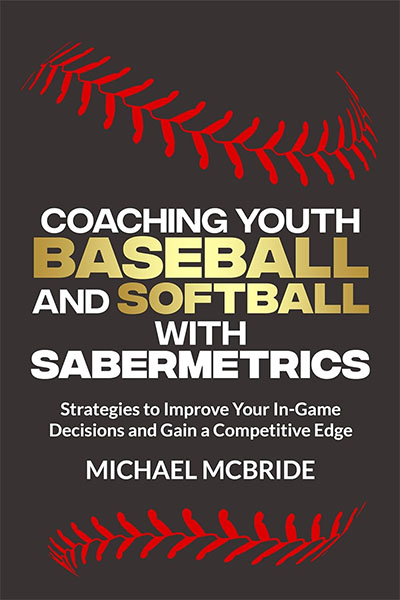Coaching Youth Baseball and Softball with Sabermetrics: Strategies to Improve Your In-game Decisions and Gain a Competitive Edge

Coaching Youth Baseball and Softball with Sabermetrics: Strategies to Improve Your In-game Decisions and Gain a Competitive Edge
- January 30, 2024
- Book two in UCI economics professor Michael McBride’s multi-part series shares how youth coaches can apply rich data to create game-winning strategies
-----

In the second installment of his multi-part book series, Coaching Youth Baseball and Softball with Sabermetrics, UCI economist Michael McBride dives into data-driven decisions coaches can incorporate directly into game-winning strategies. Widely popularized among professional play, sabermetrics as a player development and strategy-building tool is gaining traction among high school, Pony and Little League coaches, thanks in part to scorekeeping apps that put rich data straight into coaches’ hands (for more on the latter, check out McBride's first book). Below, the experimental economist and game theory professor expands on his unique sabermetrics savvy to show how concepts can be applied to create better in-game strategies – just in time for the 2024 season start.
Q: You shared with us a little bit - following the release of book one - about the motivation behind the series. Can you expand on why this series, this book and this method are important tools for youth coaches to utilize?
Absolutely! I introduce this second book with a story of when one of our coaches made a decision that hurt our team’s chances of success. It was clear from talking to him about it afterward that his decision was based on a conventional way of thinking that was wrong according to a sabermetric assessment of the situation. This was someone who had coached for years and wanted desperately for the players to succeed, but there was still a gap in his knowledge that led to a bad coaching decision.
This series is written for coaches like him who want to improve their coaching by filling in these gaps in their sabermetric understanding of the game. It introduces them to data-driven lessons that can be incorporated into their coaching without having to be a data expert. They just need a willingness and desire to learn.
The first book demonstrated how to evaluate players accurately using the statistics that most coaches can access on scorekeeping apps. It explains which stats are better to use when evaluating youth baseball or softball players, how they should be interpreted, which ones are not as revealing, and so on. These are lessons that any coach can learn if they have a little guidance.
This second book is about in-game strategy: Should you play for a big inning or play for just a single run? Should you attempt a stolen base? How should your pitchers sequence their pitches? Where should your fielders be positioned? Sabermetric analysis has overturned conventional thinking about all of these questions, but youth coaches are largely unaware of that fact. After reading this book, youth coaches will know how to make better coaching decisions. And that means putting their players in the best position to succeed and enjoy playing, which is ultimately what I want to see.
Q: Book two - Strategies to Improve Your In-game Decisions and Gain a Competitive Edge – goes into several strategy-related sabermetrics concepts. Which stats did you focus on and why?
Some of the stats are ones that most coaches are already familiar with but can be used in new ways. An example is using batting average, on-base percentage, and slugging percentage to identify a batter’s best batting approach. This is easy to do, but it is still something that many youth coaches surprisingly don’t do.
Other statistical tools, like a spray chart or a batted-ball distribution, can be created by a coach using their scorekeeping app with a little work. But these can be really useful when aligning your defense in the optimal way.
Some of the stats are actually ones that a youth coach won’t even have access to, like win probability and the break-event point. But I discuss them in the book because even just learning about them helps a coach to identify the situational factors that affect the risks and returns of different coaching decisions. These are exactly the kinds of things that the coach I mentioned earlier was unaware of, so learning about them can have an immediate and positive effect on coaching.
Q: Where do you recommend youth coaches start, if they’re new to sabermetrics, in using these advanced stats to build their game plan?
I recommend starting with the first book in the series. It provides some simple ways to immediately apply sabermetrics as a youth coach, like when setting the optimal batting lineup. This is something that coaches do before every game, and you’d be surprised how often it is done poorly because the coach has a traditional but inferior understanding of the game.
Once a coach is confident in the logic behind the optimal lineup, then they’ll be ready for the ideas about in-game strategy in the second book. For example, one of the second book’s goals is to help the youth coach understand how to accurately assess the risks and returns of different coaching decisions in different settings. This kind of awareness takes a long time to develop on its own because risks and returns depend on a lot of situational factors, like the quality of the pitcher and defense, the skill of the batter, and the score. But by reading this book a coach can get up to speed quickly on how to interpret situational factors accurately enough to make decisions that are good for the team.
-----
Would you like to get more involved with the social sciences? Email us at communications@socsci.uci.edu to connect.
Share on:
Related News Items
- Careet RightCoaching Youth Baseball and Softball with Sabermetrics
- Careet RightEconomics of Anteater life
- Careet RightA cash-for-clunkers program could reduce aviation emissions
- Careet RightSaddleback Church loses appeal over ouster from Southern Baptist Convention
- Careet RightCoaching Youth Baseball and Softball with Sabermetrics


